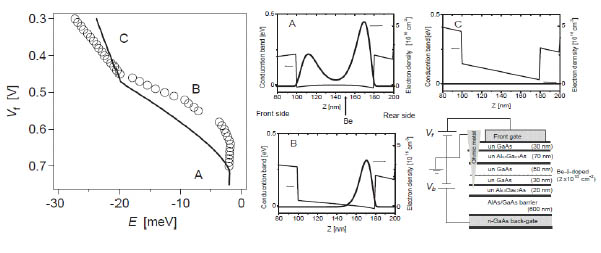Masumi Yamaguchi
Physical Science Laboratory
Producing an artificial crystal based on gate-confined semiconductor quantum dots requires the ability to control the electron density and electric field. The electron density of the two-dimensional electron system (2DES) formed at a semiconductor hetero-interface can be changed by applying a front- or back-gate bias [1]. The change in the electron density is accompanied by a change of the effective electric field since 2DES has a finite width along the confinement direction. Although the transport properties are usually sensitive only to the electron density, optical properties, such as the photoluminescence (PL), are sensitive to the electric field as well as to the electron density. It is expected that the electron density and electric fields of a semiconductor quantum well (QW) can be controlled independently by applying front- and back-gate biases.
In this research, PL from an acceptor-delta-doped GaAs QW was measured while the gate electric field was changed by applying front- and back-gate biases [2]. The sample structure is shown in Fig. 1. The open circles in the left panel of Fig. 1 denote the radiation energy of the PL peak in changing the front-gate bias. The panels A, B, and C on the right show the simulated conduction band profiles of the QW and the electron density. The front-gate bias dependence of the radiation energy has three regimes, which reflect the situation of A, B, and C. A: The conduction electrons accumulate at both sides of the QW when positive high biases are applied to both the front and back gates. In this case, the electric field in the middle part of the QW is screened by the accumulated electrons and thus the PL peak energy weakly depends on the gate biases. B: When the front-gate bias becomes small, the front-side electrons disappear and electrons exist only at the rear side. In this case, the effective electric field changes with changing the front-gate bias and the PL energy shifts largely. C: When the front gate bias is decreased further, the QW becomes empty. The simulated energy shift (solid curve in the left panel) is in good agreement with the experimental results. In addition, we found that the electric field can be changed by keeping the electron density constant in the B regime.
[1] M. Yamaguchi, et al., Suf. Sci. 583 (2005) 94.
[2] M. Yamaguchi, et al., J. Appl. Phys. (to be published).
 |
| Fig. 1. PL energy shift and simulated results. |